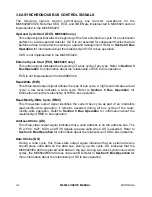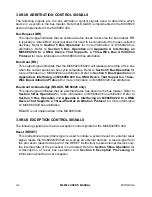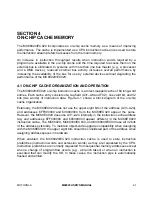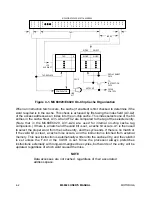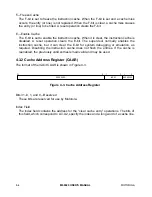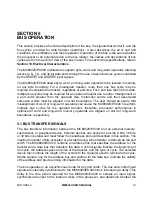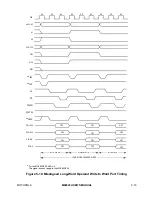
MOTOROLA
M68020 USER’S MANUAL
5- 5
5.2 DATA TRANSFER MECHANISM
The MC68020/EC020 architecture supports byte, word, and long-word operands allowing
access to 8-, 16-, and 32-bit data ports through the use of asynchronous cycles controlled
by
DSACK1/DSACK0
. Byte, word, and long-word operands can be located on any byte
boundary, but misaligned transfers may require additional bus cycles, regardless of port
size.
5.2.1 Dynamic Bus Sizing
The MC68020/EC020 dynamically interprets the port size of the addressed device during
each bus cycle, allowing operand transfers to or from 8-, 16-, and 32-bit ports. During an
operand transfer cycle, the slave device signals its port size (byte, word, or long word) and
indicates completion of the bus cycle to the processor with the
DSACK1/DSACK0
signals.
Refer to Table 5-1 for
DSACK1/DSACK0
encodings and assertion results.
Table 5-1.
DSACK1/DSACK0
Encodings and Results
DSACK1
DSACK0
Result
Negated
Negated
Insert Wait States in Current Bus Cycle
Negated
Asserted
Complete Cycle—Data Bus Port Size is 8 Bits
Asserted
Negated
Complete Cycle—Data Bus Port Size is 16 Bits
Asserted
Asserted
Complete Cycle—Data Bus Port Size is 32 Bits
For example, if the processor is executing an instruction that reads a long-word operand
from a long-word-aligned address, it attempts to read 32 bits during the first bus cycle.
(Refer to 5.2.2 Misaligned Operands for the case of a word or byte address.) If the port
responds that it is 32 bits wide, the MC68020/EC020 latches all 32 bits of data and
continues with the next operation. If the port responds that it is 16 bits wide, the
MC68020/EC020 latches the 16 bits of valid data and runs another bus cycle to obtain the
other 16 bits. The operation for an 8-bit port is similar, but requires four read cycles. The
addressed device uses the
DSACK1/DSACK0
signals to indicate the port width. For
instance, a 32-bit device always returns
DSACK1/DSACK0
for a 32-bit port, regardless of
whether the bus cycle is a byte, word, or long-word operation.
Dynamic bus sizing requires that the portion of the data bus used for a transfer to or from
a particular port size be fixed. A 32-bit port must reside on D31–D0, a 16-bit port must
reside on D32–D16, and an 8-bit port must reside on D31–D24. This requirement
minimizes the number of bus cycles needed to transfer data to 8- and 16-bit ports and
ensures that the MC68020/EC020 correctly transfers valid data. The MC68020/EC020
always attempts to transfer the maximum amount of data on all bus cycles; for a long-
word operation, it always assumes that the port is 32 bits wide when beginning the bus
cycle.
The bytes of operands are designated as shown in Figure 5-3. The most significant byte of
a long-word operand is OP0; the least significant byte is OP3. The two bytes of a word-
length operand are OP2 (most significant) and OP3. The single byte of a byte-length
operand is OP3. These designations are used in the figures and descriptions that follow.
Summary of Contents for MC68020
Page 16: ...9 29 95 SECTION 1 OVERVIEW UM Rev 1 0 xx M68020 USER S MANUAL MOTOROLA ...
Page 268: ...MOTOROLA M68020 USER S MANUAL 9 13 Figure 9 9 Access Time Computation Diagram ...
Page 286: ...MOTOROLA M68020 USER S MANUAL 10 11 Figure 10 3 Read Cycle Timing Diagram ...
Page 287: ...10 12 M68020 USER S MANUAL MOTOROLA Figure 10 4 Write Cycle Timing Diagram ...
Page 288: ...MOTOROLA M68020 USER S MANUAL 10 13 Figure 10 5 Bus Arbitration Timing Diagram ...


